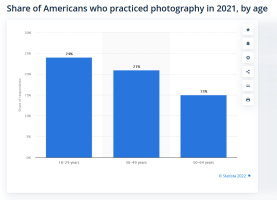Adding a smiley face doesn't conceal your bitterness towards us "cashed-up retirees" who spent most of our lives working hard, raising families, paying for our kids' education, scrimping and saving for retirement and often delaying that retirement for years. We have the opportunity to treat ourselves to things we never could before and want to enjoy ourselves for a few years before we are too old and feeble to do anything. If that offends you...well tough.
Thanks for explaining what annoyed you in my post, now I understand how you've misunderstood me and can offer some clarification.
Firstly, there's no bitterness, Canon's antics are a mild inconvenience to me at worst, and people's emotional reactions to Canon's shenanigans are kind of amusing from a human behaviour perspective, hence the smileys!

The whole point of mentioning retired old men was not to spite them, they're the majority of participants on most photography forums, possibly except for exclusively Sony camera forums which have disproportionate numbers of younger male gear-heads who are into 'technology for technology's sake' and usually work in the information technology field lol! It's about understanding demographics, pure and simple.
I've already pointed out in other threads to readers here, that we on this forum aren't representative of the greater Canon camera gear market, and only represent a narrow niche group. This was to help gain perspective why Canon does what it does, and how the bulk of photography gear sales come from entry level Rebel and M-series ASPC gear to everyday people and beginners.
It's irrational for anyone to spite retirees who have worked hard and have chosen to spend their money enjoying themselves however they please. That kind of resentment usually comes from a much younger generational 'okay boomer' crowd which is directed against the baby-boomer generation. That kind of nonsense doesn't interest me.
Here's a breakdown of photography by age groups in the US - source is
https://www.statista.com/statistics/227424/number-of-photographers-usa/
A total of, 42,093 respondents, 18-64 years of age were surveyed.

The older 50-65 years age group only accounts for 15% of people practicing photography in some form or other. The retirement age in the US is around 65-67, and this data doesn't include the over 65 retirees.
The photography gear used by these age groups would differ, based on their subcultures and disposable incomes. It would be safe to assume that the biggest group, the 18-29 year olds, are mainly smartphone photographers, and conversely, the majority of people with flagship camera bodies and top tier wildlife super telephoto lenses are likely in the older age groups.
When we look at the world of photography, we have to remember that the market has contracted drastically, and potentially may continue to do so. Alongside this is a progressive generational shift towards smartphones as a means of accessible photography and videography for social media, which is centred more around creative expression rather than professional quality of production. This is point-and-shoot culture reaching a whole new level.
With the progression of age, and succession of generations, the culture shifts, and so does the market for certain products. The photography companies are navigating a shrinking market in a shifting and uncertain landscape, while trying to stay competitive. Canon is no longer in the boom phase of the camera industry's heyday, so their product range, marketing strategies and target market will change accordingly in response to the change. Being a completely different situation from the past, we can expect things to stay the same, or operate with the same certainty.
I totally agree, our relationship as buyers to a corporation whose gear we invest in is purely transactional, but anyone would be forgiven for thinking otherwise when they see the emotional investment and identification with a brand that occurs on some forums where people get into tribal brand wars.
Put simply, Canon's concern is to maximise profits and gain market share.
What buyers want is choice, and value for money. When it comes to gear ecosystems, some clarity on the range of products that will be available in anew system.
Canon's pursuit of their goals can be at the expense of the buyers needs, if they believe they can get away with it, and it won't hurt future sales, so their actions aren't necessarily always benevolent to buyers, nor do they need to be. Cutting edge products such as the 28-70mm f/2 lens allow the company to showcase the best they can offer technologically, which is great PR for the company, and draw buyers of top tier-gear. Many companies offer specific products that are very attractive to new buyers of a system, to lure them in, these are products that may have excellent performance for non-premium items, and they may be offered at little to no profit to provide unbeatable value for money as a drawcard to entice people in, who will then buy other gear which subsidises the prices of the latter. This is the gear that 'punches above its price range', and is a real win for the buyer short term, and for the manufacturer in the long term.
This all raises the question, where is Canon going with all this?
Will the EF-S grade and non-premium full-frame lens markets ultimately be consolidated into a single, large, vaguely defined group of 'RF budget lenses', with a super cheap yet-to-come RF camera body as the potential replacement to the Rebel series if Canon chooses to or has to go that way in an uncertain market? That's assuming the M-series stays, considering it is a mirrorless platform and the Rebel series are the older DSLRs.
Companies have to respond to the shifts in the market. With the lens range on offer, it does lend itself to Canon possibly pushing into a premium territory, while offering a basic collection of entry level lenses and bodies to bring people into the ecosystem. That may explain the conspicuous absence of mid-range lenses, which appeal to a certain demographic, that isn't the young smartphone photographers, nor the retirees who can buy premium lenses. It may also explain why third party lens manufacturers are either ignoring Canon's RF platform, or being prevented from releasing RF lenses to reduce competition, depending on who you ask.
Dustin Abbott mentions the glaring gap in RF lens line up in the video below:
It's still early days on the RF platform, but with a limited range of lenses available, many overpriced, and a clear absence of third party offerings, the factors that satisfy buyers, namely choice, and value for money, are far from optimal right now. There's no reliable indicator as to which way things will change, which doesn't instill buyer confidence. These are my criticisms of Canon, but if people wish to believe (because it can't be objectively true) that their favourite company can do no wrong, then so be it, nothing much can change that.

Personally, I'm only a just a little annoyed that I can't get a decent mid-range 85mm right now. I'm interested in working with that focal length after seeing the type of images it can produce at apertures of 1.2-1.4, and noticing I'm on this focal length on my L-series RF zoom often. The RF 85mm f/2 macro looks very sharp and can focus closer than any other 85mm, but this lens with excellent sharpness and contrast produces a mediocre and overly contrasty (non smooth and a bit busy) bokeh, plus Canon put a crappy STM system into it which messes the AF system. I could buy the Canon or Sigma Art EF 85 1.4s used, but it would be nice to have the convenience an RF lens rather than invest more in a superseded lens mount. First world problem really, I don't need it, just want it to learn on and perhaps incorporate it into my work.
Hope that's much clearer!


